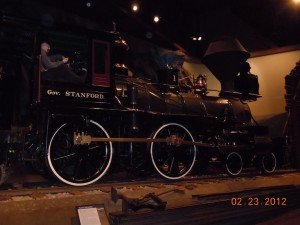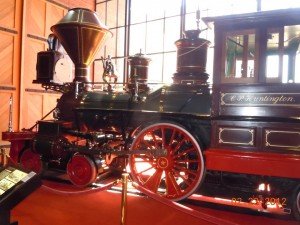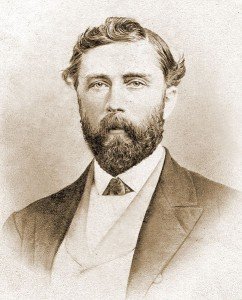The Central Pacific Railroad operated the last western segment of the first transcontinental railroad in the U.S. The railroad was built between California and Utah. It was the Central Pacific Railroad that had the formidable task of building a railroad line over the beautiful yet wild and rugged Sierra Nevada Mountains.
Thank you for reading this post, don't forget to subscribe!There was no question but the route over the Sierra Nevada’s presented the biggest challenge to completing the transcontinental railway. The next step was to purchase the right type of steam locomotives.

Congress opened the way for the transcontinental railroad during the Civil War years when the Republicans were in control.
Prior to that time, when possible routes were discussed, Southern Democrats pushed hard for a southern route to California which would serve southern cities in the east. With the war raging and the Southern Democrats having seceded, the door was wide open to pick the central overland route for the transcontinental railroad. The federal government issued railroad bonds to help with financing. This was the biggest step taken in American railroad history.
The Central Pacific Railway was operated by what was referred to as the “Big Four“. In this case, the Big Four represented Leland Stanford, Collis Huntington, Mark Hopkins and Charles Crocker. Many are still familiar with these names today. They were a politically powerful and wealthy California combination. They were four very successful Sacramento California area merchants and in the 1850’s Sacramento California, with the gold mines in full force, was a profitable place to do business.
In addition to constructing rail lines over mountains and through deserts, the Central Pacific needed to purchase locomotives that were built back on the east coast. The locomotive would have to be sent by ship, around Cape Horn, and then to the port of San Francisco. To accomplish this, the locomotive was shipped in parts and then assembled when it reached it’s destination.

The very first locomotive of the Central Pacific Railroad was named The Governor Stanford.
The Governor Stanford was called a 4-4-0 locomotive built by the Norris Locomotive Works in 1862 during the American Civil War.The locomotive was built in Philadelphia Pennsylvania.
This forty-ton wood burning steam locomotive was the pioneer engine of the Central Pacific Railroad. The 4-4-0 designation on the early steam locomotives had to do with suspension and adherence to the track.
Early railroad tracks were not what they are today and locomotives had to be stable and adhere enough to stay on the tracks. The first North American locomotives were actually 0-4-0 which didn’t really have good enough suspension systems. Next was the 4-2-0 which had a three point suspension system. The Governor Stanford, being a 4-4-0 was an improvement with an extra pair of driving wheels added. The adherence to the track was much greater and this was critical over relatively steep mountain grades.
In 1863, the Central Pacific purchased another locomotive, this one a 4-2-4. The locomotive was built by the Cooke Locomotive Works in Paterson New Jersey. The company built steam locomotives from 1852 until 1901.
The locomotive was named the CP Huntington after the Big Four’s Collis P. Huntington. This was the railroad’s third locomotive, the first to being the Stanford and the Pacific. The Huntington eventually was purchased by the Southern Pacific Railroad in 1871 and represented that railroad’s very first steam locomotive.

Another historic locomotive purchased by the Central Pacific Railroad was the T.D. Judah.
This locomotive, a 4-2-4 and also built by the Cooke Locomotive Works, was named in honor of Theodore Judah, the Central Pacific’s first engineer.
It was also built in 1863 and later rebuilt as a 4-4-2. An interesting side note that many may not know is that both the Judah and Huntington locomotives were originally built for a railroad who couldn’t pay for them. Collis Huntington saw them at the Cooke plant and decided to make the purchase.
Theodore Judah made railroad history in his own right. He was the original surveying engineer who plotted the route across the massive Sierra Nevada Mountains.
Judah was also noted for his use of snow sheds along the mountain route which helped keep the passes open for the trains. Theodore Judah had dreamed about a transcontinental railroad for years and his engineering skill helped make it a possibility, especially determining a way to build over the mountains. It was Judah who also lined up the wealthy investors to help make it a reality. The downside for Judah was when the Big Four, the money men, essentially cut him out of the decision making after taking over the Central Pacific.
Another trips Into History photo article you may enjoy is The Leland Stanford Mansion in Sacramento california.
You can still see examples of the Sierra Nevada snow sheds when you travel through those mountains on today’s Interstate 80. Essentially the same route plotted by Judah in the mid 1800’s is still in use by Amtrak’s California Zephyr which operates between Chicago and Emeryville California across the Bay from San Francisco.
If you happen to be traveling through the Sacramento California area on business or for a California vacation, you’ll very much enjoy a stop at the California State Railroad Museum in Old Town Sacramento. You’ll be able to view one of the finest displays of vintage locomotives and rail cars in the U.S. The museum is very impressive and quite interesting for the entire family.
(Article and photos copyright Trips Into History. Judah photo from the public domain)
